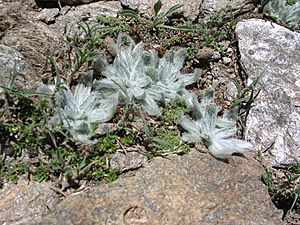Plantago nivalis facts for kids
Quick facts for kids Plantago nivalis |
|
|---|---|
 |
|
| Scientific classification | |
| Genus: |
Plantago
|
| Species: |
nivalis
|
| Synonyms | |
|
Plantago thalackeri Pau |
|
Plantago nivalis, also known as the Snow Plantain, is a special kind of flowering plant. It belongs to the Plantaginaceae family, which includes many types of plantains. This unique plant is found only in the high mountains of the Sierra Nevada in Spain. It's known for its ability to grow in very cold, snowy places.
Contents
About the Snow Plantain
The Snow Plantain is a small, tough plant that has adapted to live in harsh mountain environments. It's a rare species, meaning it's not found in many places around the world. Its scientific name, nivalis, comes from the Latin word for "snowy," which perfectly describes where it lives.
Where Does It Grow?
The Snow Plantain makes its home in the Sierra Nevada mountain range in southern Spain. This area is known for its tall peaks and long winters with lots of snow. You can find Plantago nivalis growing in rocky areas and on slopes, often at very high altitudes. It prefers places where the snow melts slowly, providing it with water throughout the spring and summer.
What Does It Look Like?
This plant is quite small, usually growing only a few centimeters tall. It forms a tight, cushion-like shape close to the ground. This shape helps it stay warm and protected from strong winds. Its leaves are narrow and often covered with fine hairs, which can help trap warmth and reduce water loss.
When it blooms, the Snow Plantain produces small, pale flowers. These flowers are often white or yellowish and grow in a dense cluster at the top of a short stem. The plant's overall appearance helps it blend in with its rocky, snowy surroundings.
How Does It Survive in the Snow?
Living in the Sierra Nevada means dealing with extreme cold, strong winds, and heavy snow for much of the year. The Snow Plantain has developed several amazing ways to survive:
- Cushion Shape: Its compact, low-growing form helps it avoid the worst of the wind and keeps it insulated.
- Hairy Leaves: The tiny hairs on its leaves act like a warm blanket, protecting the plant from cold and helping it hold onto moisture.
- Deep Roots: It likely has a strong root system that anchors it firmly in the rocky soil and helps it find water.
- Short Growing Season: The plant grows and flowers quickly during the short summer months when the snow has melted.
Life Cycle and Reproduction
Like many alpine plants, the Snow Plantain has a short but busy growing season. After the snow melts in late spring or early summer, the plant quickly starts to grow. It produces its flowers, which are then pollinated, likely by insects that are also active in the mountains.
After pollination, the plant forms small seeds. These seeds are designed to survive the harsh winter. They might be spread by wind or small animals. When spring arrives again, and the conditions are right, the seeds can germinate and start the cycle anew. This ability to complete its life cycle quickly is key to surviving in a place with such a short warm period.
Why Is It Important?
The Snow Plantain is important for several reasons:
- Biodiversity: It adds to the variety of life found in the Sierra Nevada. Every species plays a role in the ecosystem.
- Indicator Species: Because it's so sensitive to its environment, changes in the Snow Plantain's population can tell scientists about the health of the mountain ecosystem, especially how it's affected by climate change.
- Unique Adaptations: Studying how this plant survives in extreme conditions can teach us about plant resilience and evolution.
Conservation Efforts
Because the Snow Plantain is rare and lives in a specific, fragile environment, it is considered a vulnerable species. This means it needs protection to make sure it doesn't disappear. Efforts to protect it include:
- Habitat Protection: The Sierra Nevada is a national park, which helps protect the plant's natural home from human activities.
- Research: Scientists study the plant to understand its needs and how best to protect it.
- Awareness: Educating people about the importance of unique plants like the Snow Plantain helps gather support for conservation.
It's important for everyone to respect natural habitats and help protect special plants like the Snow Plantain for future generations.
See also
- In Spanish: Estrella de las nieves para niños

